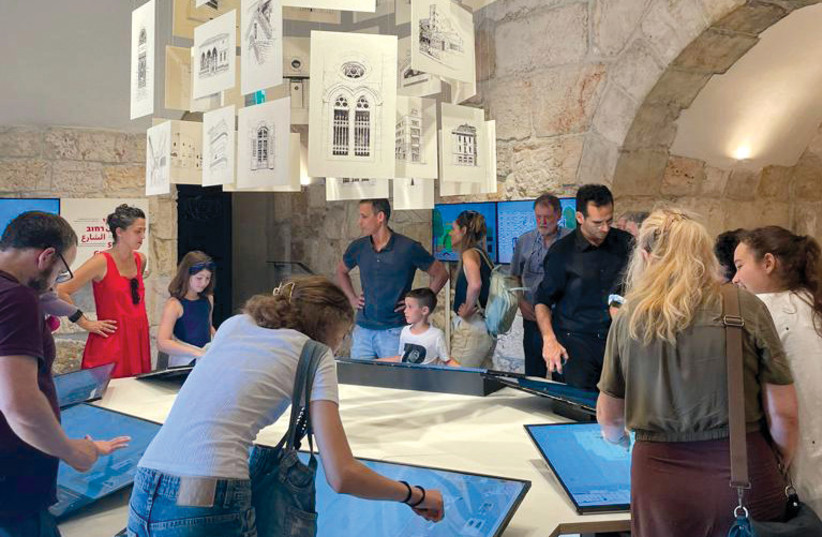The city of Jerusalem showcases a veritable variety of architecture all the way from the Old City walls to the modern bricks of the new city. Visitors to Jerusalem, noticing the stark contrast in building styles, want to learn more about the history behind each street in order to unravel its distinctive architectural foundations, and this is exactly what the Tower of David Jerusalem Museum’s newest temporary exhibition, “Street Games,” is about.
An architectural-interactive experience based on the books of architect David Kroyanker, the “Streets Games” exhibit aims to educate visitors by encouraging them to explore some of the most recognizable architecture in the city – and to digitally create new buildings of their own in a similar style.
“The architecture in Jerusalem acts as a time capsule, and you can see the microcosms of the different cultures here, reflected within the buildings,” explained Eilat Lieber, director and chief curator of the museum.
The exhibit is designed to allow visitors to familiarize themselves with more information about Jerusalem’s architecture while simultaneously encouraging their creativity.
“Everything in Jerusalem is symbolic,” Lieber said. “We want people to be able to recognize in the streets the details that they see in the game.”


Getting to know the architecture of Jerusalem
“Street Games” highlights the architecture of five major streets in Jerusalem, as well as that of the Old City walls. The streets highlighted include Emek Refaim, Hanevi’im, Mea She’arim, Ramban, and Jaffa.
Since “Jerusalem is not like any other city,” Lieber said, “playing the game can be the first step in getting to know the architecture in Jerusalem and beginning to understand how it came to be.”
Architect Dana Gordon helped curate the exhibition and design the assets of the game for each street.
“Each of the five streets is different in the way that its architecture was constructed,” Gordon said. “For example, Mea She’arim represents the Jewish community and neighborhoods in Jerusalem, while Hanevi’im has buildings that represent Christian culture.”
Her designs for the exhibit were influenced by the work of popular Israeli architect Kroyanker, who studied Jerusalem’s architecture and wrote many books about it.
“The starting point was to think about the architecture of Jerusalem through the lens of David Kroyanker’s books, and to translate the basis of the Jerusalem architecture into a format that is digitalized and interactive,” Gordon said.
The exhibit includes many building styles from across the capital city that can be combined together within the digital application to make new styles.
It is, Gordon said, “very important to us that the visitors experience the room in a way” that made them feel “as if they are creators.”
As the visitors enter the “Street Games” exhibition, a screen allows them to choose a starting street and visualize some of its architectural elements. “When you tap on the different assets, it will show you more information about that design,” said Yoav Cohen, the artistic and digital media director of the exhibition.
The application was designed to offer a full range of creative control over the assets, including their size and scale in the workspace.
“We tried to design the workspace in the application to look like a studio,” Cohen said.
Users of the application can drag and drop whichever assets they would like into the workspace to create their buildings.
“It’s not only educational and historical, but it’s [also] just meant to be fun,” Gordon said.
When the visitors are done making their creations, they are displayed on the wall for others at the exhibit to see. The wall display will be constantly changing as new visitors come and create.
“Street Games” runs until the end of April and is the Tower of David Museum’s first temporary exhibit.
“We decided to open up temporary exhibitions in the courtyard of the citadel because Jerusalem is a treasure trove of content, and we’re always finding new stories within it that we want to highlight,” Lieber said.
She explained that this was just the beginning of introducing temporary exhibits to the museum. The hope is to develop more in the future, as the city itself simultaneously changes.
“When you have just a thousand meters to show the history of Jerusalem, you have to choose what to show in the permanent exhibit and what you must lose,” Lieber said. “Everything we couldn’t include before, we can put in temporary exhibitions now.”
With the worldwide trend of constantly looking for something new to focus on, the museum too must keep up with this fast-paced rhythm or risk being left behind. “The core of this museum is the history of the city, but that’s not enough,” she said. “The new concept of the museum is not just focused on the past but also on the present and the future.”
There are hopes that the technology used in this and future temporary exhibits to come will help to engage visitors of the younger generations.
“The younger generation can be bored by history, so we must find a new language to engage them with, and that language is technology.”
“The way the story of Jerusalem is being told has been completely revamped to include interactive concepts,” Lydia Weitzman, a representative from the Tower of David Museum, said.
The museum’s mission to educate the visitors of Jerusalem about the city takes center stage in the exhibit amongst the interaction and immersion through technology, she said.
“We are driving forward this museum – which has layers and layers of history going back so many thousands of years – into the 21st century, and making sure that every visitor will come out with a better understanding of Jerusalem,” Weitzman said.
The “Street Games” temporary exhibit will, she said, “add another layer of meaning and curiosity” to the history of Jerusalem. ❖












